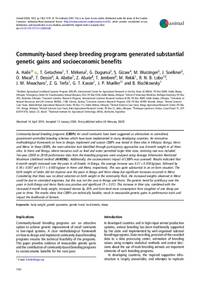Community-based sheep breeding programs generated substantial genetic gains and socioeconomic benefits

Authors:
Community-based breeding programs (CBBPs) for small ruminants have been suggested as alternatives to centralised, government-controlled breeding schemes which have been implemented in many developing countries. An innovative methodological framework on how to design, implement and sustain CBBPs was tested in three sites in Ethiopia: Bonga, Horro and Menz. In these CBBPs, the main selection trait identified through participatory approaches was 6-month weight in all three sites. In Horro and Bonga, where resources such as feed and water permitted larger litter sizes, twinning rate was included. Ten-year (2009 to 2018) performance data from the breeding programs were analysed using Average Information Restricted Maximum Likelihood method (AI-REML). Additionally, the socioeconomic impact of CBBPs was assessed. Results indicated that 6-month weight increased over the years in all breeds. In Bonga, the average increase was 0.21 +/- 0.018 kg/year, followed by 0.18 +/- 0.007 and 0.11 +/- 0.003 kg/year in Horro and Menz, respectively. This was quite substantial in an on-farm situation. The birth weight of lambs did not improve over the years in Bonga and Horro sheep but significant increases occurred in Menz. Considering that there was no direct selection on birth weight in the community flock, the increased weights observed in Menz could be due to correlated responses, but this was not the case in Bonga and Horro. The genetic trend for prolificacy over the years in both Bonga and Horro flocks was positive and significant (P< 0.01). This increase in litter size, combined with the increased 6-month body weight, increased income by 20% and farm-level meat consumption from slaughter of one sheep per year to three. The results show that CBBPs are technically feasible, result in measurable genetic gains in performance traits and impact the livelihoods of farmers.
